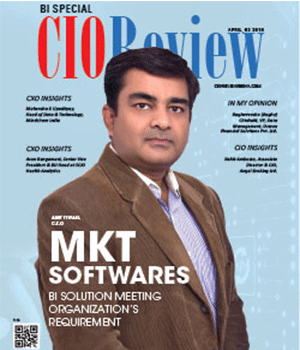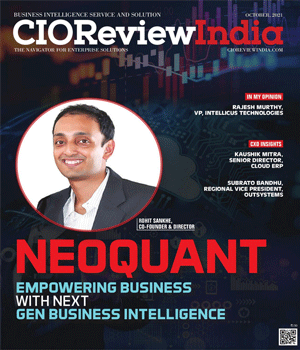
CIO's Role in Deriving Optimal Value through Business Intelligence Project
Shubhendu Dutta, Director- IT, MTS Sistema Shyam Teleservices Ltd
 As the pace of digitization has increased, the organisations are inundated with data that is proving to be a potential asset for them. According to Frost and Sullivan study, almost 90 percent of the data in the world has been generated in last two years. This huge data set is of no use if it is not properly harnessed to derive a meaningful information using the analytical tools. Therefore, organisations across the world are focusing on transforming data into information and knowledge that will enable them to take the right business decisions. IDC reports the current market size of BI as $ 17 B and is growing at a CAGR of nearly 10 percent. This suggests that business is now according high priority to gaining deeper customer insight, forecasting the demand of their products and market share, predicting the talent churn from companies and granular understanding of supply chain processes to bring more value to business using advanced business analytics tools. While various industry reports indicate increased investment in analytics platform by firms, it is often found that they are unable to exploit the full potential of the platform.
As the pace of digitization has increased, the organisations are inundated with data that is proving to be a potential asset for them. According to Frost and Sullivan study, almost 90 percent of the data in the world has been generated in last two years. This huge data set is of no use if it is not properly harnessed to derive a meaningful information using the analytical tools. Therefore, organisations across the world are focusing on transforming data into information and knowledge that will enable them to take the right business decisions. IDC reports the current market size of BI as $ 17 B and is growing at a CAGR of nearly 10 percent. This suggests that business is now according high priority to gaining deeper customer insight, forecasting the demand of their products and market share, predicting the talent churn from companies and granular understanding of supply chain processes to bring more value to business using advanced business analytics tools. While various industry reports indicate increased investment in analytics platform by firms, it is often found that they are unable to exploit the full potential of the platform.
Business intelligence as a technology domain, has evolved over the last 15 years addressing the business problem in various aspects. It has evolved through four phases viz. descriptive, diagnostic, predictive and prescriptive (Fig1). In its simple form, the descriptive analytics rely on the analysis of historical data with the facility to intuitively understand the data using interactive dashboards. The diagnostic phase of analytics attempts to understand the “why” part of the business scenario thereby prompting the managers to focus on the actual problem. With growing uncertainty in business environment, predictive analytics is gaining momentum which attempts to forecast the business KPIs based on current trend along with the changing external environment. However, the latest trend in analytics, termed as advanced analytics, is based on prescriptive approach to offer real time automated business solution by churning huge volume of data from various sources. Industries such as Banking, Finance and Insurance, Telecom, Retail and e-commerce are leading the investment wave in business intelligence solution to transform their business, but the real benefits to business vary across sectors.
In order to fully exploit the potential of a BI solution the organisations need to develop a BI capability framework that will permeate through the entire organization. Based on some rich learnings through the implementation of an enterprise wide BI project, a set of best practices are proposed below:
1. Create a business run BI Governance structure:
The BI governance team should consist of committed and engaged business sponsors across the business units. Commitment can be gauged through compulsory attendance without the scope of delegation for the business sponsors. Priorities for BI can be altered by the business sponsors in due consultation with IT team.
2. Develop business IT hybrid who understands the business well:
A core team comprising the business and IT together should be formed to help amalgamate the business and IT domains. This will help aligning the reporting and analysis requirement with the business needs,
3. Narrow down your BI application choice to meet the realistic business goals:
At the organization level, the objective for BI application should be clearly stated e.g the need to identify the customer churn propensity, business operations performance dashboard, customer buying behavior analysis etc. By clearly stating the business objectives, it becomes easy to get the required funding.
4. Create easy to use interface in self- service mode:
One of the purpose of BI system is to allow business users to experiment with the data set and create their own analytical reports. To accomplish this objective, BI solution should have a rich user interface that can minimize the dependency on IT support team and can help enhancing the adoption level in the organization.
5. Focus on the basics of data management:
The core of BI system is the data quality, standards and meta data. Poor data quality erodes the confidence of business and it eventually affects the adoption of BI system. It is often a challenge to maintain the data consistency in the data warehouse when you have numerous operational systems maintained by multiple vendors. Therefore, bringing all the vendors together to follow a common data standard is paramount for the success of BI project.
6. Taking an enterprise view of data:
A clear and consistent meaning of business data at an organization level needs to be maintained through data governance practices. For instance, the customer churn needs to be uniformly defined across organization to have same meaning for all the functions.
Thus a CIO should act as an evangelist for BI solution and ensure that business is according the right priority to the project for its overall success while doing his bit of work on maintaining the data quality for developing a trust on the derived information through the analytic system.
CIO Viewpoint
Why Foolproof Facial Recognition Is Key Against...
By Joseph Sudheer Thumma, Global CEO & MD, Magellanic Cloud
National Technology Day 2025: Powering Progress...
By CIOTech Outlook Team
Aligning IT Roadmap with Business Objectives: A...
By Subhash singh Punjabi, CISO & Head Enterprise Architecture, Deepak Fertilisers & Petrochemicals Corporation Ltd
CXO Insights
Three ESG Strategies for Sustainable Business...
By Jyotsna Beliappa, Founder and Director, BlueSky Sustainable Business
Importance of Data Driven reporting & Decision...
By Ketan Karkhanis, Head of Information Technology, Hikal
Pursuit of Actionable Insights Driving Data...












